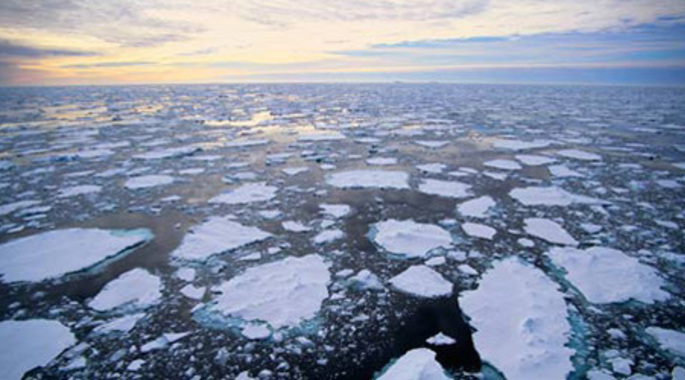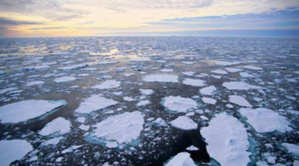There are large volumes of carbon dioxide and methane trapped in the arctic frozen soil. As the temperature in the Arctic increases, these amounts will be eventually released.
The researchers first calculated the rate at which permafrost thaw releases greenhouse gases. Then they estimated the cost of mitigating the effects of these additional volumes.
According to researchers from Cambridge and the University of Colorado, these emissions are costly for our planet: in 2200, the damage caused by greenhouse gas emissions may reach $ 43 000 000 000 000.
That's more than $ 230 billion per year, $ 26.5 million every hour.
Direct economic impacts include loss of livestock or, for example, increasing the use of energy for air conditioning. Indirectly, this will affect human health, ecosystems; rising sea levels will cause more frequent natural disasters.
The effects will be felt around the world, says one of the authors, a Cambridge scientist Chris Hope.
Scientists are drawing world’s attention to the issue of melting Arctic ice with increasing global temperatures, but the permafrost, hidden beneath the surface of the earth, bears no less profound problems.
- Thawing permafrost is likely to be one of the main impacts of climate change in the Arctic," - say the authors of the study.
According to Hope, calculation of the economic effect will bring real benefits. We can use it when calculating risks and benefits, which are carried out for decisions on climate change.
Scientists are optimistic about the future: mankind still has opportunities to reduce emissions. Losses from melting permafrost could be reduced from $ 43 trillion to $ 6 trillion, and this is a very good save.
There is a risk that climate change will happen faster or be more costly than expected, and may even threaten the very existence of mankind. Therefore, it is necessary today to reduce harmful emissions to slow global warming and reduce the threat of the tragic end of civilization on Earth.
Assuming that humanity must take radical steps in the fight against warming that could slow economic growth, it is necessary to be sure that living in the moment people are conscious about important benefits that will be available in 50, 100 or 500 years.
Scientists use the discount interest rate from 4% to 6% (normal forecast average rate of return on investment) during numerous simulations of climate. They do it in order to calculate the present value of the future benefits of reducing emissions today. This rate means that people must do something to save the planet, yet do little.
A lower discount rate of 1.4%, proposed by Nicholas Stern in a study on the economic risks of climate change, means that humanity is ready to spend heavily now to protect future generations.
For 15 years, control of emissions of sulfur would allow slowing the growth of air temperature in the Arctic by 2 degrees. Caring about the environment would help humanity to win all the negative climate of the North Pole back in the last hundred years. Sulphur emissions in 10 years could be reduced by 90%, experts say.
Talking about the total melting of glaciers will be possible only after 200 years. If the water level rises to 12 feet, the picture will look much gloomier. 73% of Miami will be underwater, as well as 22% in New York and 20% in Los Angeles. The expansion of economic activities in the Arctic could lead to a revision of these forecasts for the worse.
source: ibtimes.com
The researchers first calculated the rate at which permafrost thaw releases greenhouse gases. Then they estimated the cost of mitigating the effects of these additional volumes.
According to researchers from Cambridge and the University of Colorado, these emissions are costly for our planet: in 2200, the damage caused by greenhouse gas emissions may reach $ 43 000 000 000 000.
That's more than $ 230 billion per year, $ 26.5 million every hour.
Direct economic impacts include loss of livestock or, for example, increasing the use of energy for air conditioning. Indirectly, this will affect human health, ecosystems; rising sea levels will cause more frequent natural disasters.
The effects will be felt around the world, says one of the authors, a Cambridge scientist Chris Hope.
Scientists are drawing world’s attention to the issue of melting Arctic ice with increasing global temperatures, but the permafrost, hidden beneath the surface of the earth, bears no less profound problems.
- Thawing permafrost is likely to be one of the main impacts of climate change in the Arctic," - say the authors of the study.
According to Hope, calculation of the economic effect will bring real benefits. We can use it when calculating risks and benefits, which are carried out for decisions on climate change.
Scientists are optimistic about the future: mankind still has opportunities to reduce emissions. Losses from melting permafrost could be reduced from $ 43 trillion to $ 6 trillion, and this is a very good save.
There is a risk that climate change will happen faster or be more costly than expected, and may even threaten the very existence of mankind. Therefore, it is necessary today to reduce harmful emissions to slow global warming and reduce the threat of the tragic end of civilization on Earth.
Assuming that humanity must take radical steps in the fight against warming that could slow economic growth, it is necessary to be sure that living in the moment people are conscious about important benefits that will be available in 50, 100 or 500 years.
Scientists use the discount interest rate from 4% to 6% (normal forecast average rate of return on investment) during numerous simulations of climate. They do it in order to calculate the present value of the future benefits of reducing emissions today. This rate means that people must do something to save the planet, yet do little.
A lower discount rate of 1.4%, proposed by Nicholas Stern in a study on the economic risks of climate change, means that humanity is ready to spend heavily now to protect future generations.
For 15 years, control of emissions of sulfur would allow slowing the growth of air temperature in the Arctic by 2 degrees. Caring about the environment would help humanity to win all the negative climate of the North Pole back in the last hundred years. Sulphur emissions in 10 years could be reduced by 90%, experts say.
Talking about the total melting of glaciers will be possible only after 200 years. If the water level rises to 12 feet, the picture will look much gloomier. 73% of Miami will be underwater, as well as 22% in New York and 20% in Los Angeles. The expansion of economic activities in the Arctic could lead to a revision of these forecasts for the worse.
source: ibtimes.com






